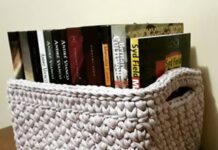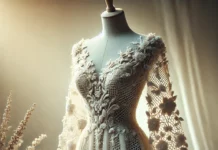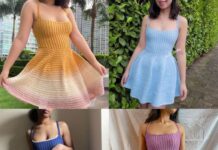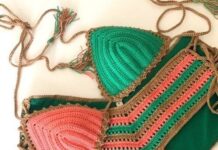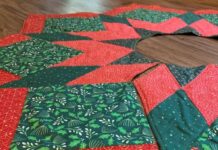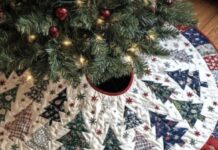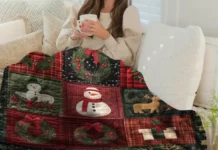Welcome to our guide on sewing two jelly roll baby quilts at once. We’ll show you how to make beautiful quilts using baby quilt patterns. This tutorial is perfect for making stunning quilts for baby gifts or personal use.
Jelly roll quilts are unique and colorful, making them a joy to create. Our tutorial will guide you through sewing two quilts at once. It’s a fun and efficient way to make baby quilts, whether you’re new or experienced.
Key Takeaways
- Learn how to sew two jelly roll baby quilts at once using our comprehensive quilting tutorial
- Discover the benefits of using jelly roll quilts and baby quilt patterns
- Understand the basics of quilting and how to apply them to your project
- Get tips and tricks for efficient batch sewing and quilting techniques
- Learn how to add the final touches to your quilts, including beautiful borders and binding
- Find out how to care for your finished quilts and keep them looking their best
Understanding Jelly Roll Quilts for Beginners
Quilt sewing is a fun hobby, especially with jelly roll strips. If you’re new to quilting, learning about jelly roll quilts is key. A jelly roll is a bundle of fabric strips, 2.5 inches wide, for making various quilt patterns.
Working on two quilts at once is great. It lets you use the whole jelly roll for two beautiful quilts. This method also saves time and reduces waste. You’ll need basic sewing skills, like using a sewing machine and sewing straight lines.
What is a Jelly Roll?
A jelly roll is a convenient fabric bundle for quilting. It offers a set of strips for a cohesive design. These strips are high-quality cotton, in many colors and patterns.
Benefits of Making Two Quilts Simultaneously
Making two quilts at once has many benefits. It uses the whole jelly roll, saving time and reducing waste. Plus, you get two unique quilts, perfect for gifts or personal use.
Basic Skills Needed
To start with jelly roll quilts, you need basic skills. These include:
- Knowing how to use a sewing machine
- Being able to sew straight lines
- Understanding basic quilting techniques
With these skills and practice, you can make beautiful quilts. Enjoy the rewarding hobby of quilt sewing.
| Quilting Skill | Description |
|---|---|
| Basic Sewing | Knowledge of how to use a sewing machine and sew straight lines |
| Quilting Techniques | Understanding of basic quilting techniques, such as piecing and binding |
| Pattern Reading | Ability to read and follow quilting patterns |
Essential Materials and Tools for Your Baby Quilt Project
To make beautiful baby quilts, you need the right stuff. You’ll need a jelly roll, background fabric, batting, and binding. Also, a sewing machine, rotary cutter, and quilting needles are key.
Think about the theme and colors for your quilt. Pick fabrics that are soft and safe for babies. A good sewing machine and rotary cutter help with precise cuts and smooth stitching.
- Jelly roll: A pre-cut bundle of fabric strips
- Background fabric: A solid-colored fabric for the quilt’s background
- Batting: A layer of insulation between the quilt top and backing
- Binding: A strip of fabric that finishes the quilt’s edges
- Sewing machine: A machine for stitching the quilt layers together
- Rotary cutter: A tool for cutting fabric strips accurately
- Quilting needles: Specialized needles for hand-quilting or machine-quilting
With these materials and tools, you’re ready to make amazing baby quilts. They’ll be loved for many years.
Preparing Your Jelly Roll Strips
To make beautiful baby quilts, you need to prepare your jelly roll strips well. This step helps you see how your quilt will look. It also makes the assembly process easier and saves time.
Sorting and organizing your jelly roll strips is key. Group similar colors together. Then, make strip sets that look good together. This planning makes the assembly smoother.
Sorting and Organizing Colors
Sorting colors is a big part of preparing your strips. Use a color wheel to pick colors that match. Think about your quilt’s theme and the person it’s for to pick the right colors.
Creating Strip Sets
Creating strip sets is another important step. Mix colors to make interesting sets. Use light and dark colors and different patterns to add depth.
By following these steps, you’ll make beautiful baby quilts. Stay organized and try new colors and patterns. This will make your quilts truly special.
Creating Your Perfect Baby Quilt Design
Now that your jelly roll strips are ready, it’s time to start your baby quilt. Think about the theme, colors, and style you want. You can try out different quilt patterns, from simple to complex.
Remember, the most important thing is to have fun making this quilt. It should be something you and the baby will love. Here are some tips to help you get started:
- Choose a theme that resonates with you and the baby, such as a cute animal or a soothing color palette.
- Experiment with different quilt patterns, such as a chevron or a hexagon design.
- Consider the colors and fabrics you want to use, and make sure they are soft and comfortable for the baby.
Baby quilt designs can be endless. You can make a quilt that shows off your style and the baby’s personality. Some popular patterns for babies include:
- Strip quilts: simple and easy to make, perfect for beginners.
- Chevron quilts: modern and trendy, great for adding a touch of sophistication.
- Hexagon quilts: intricate and beautiful, perfect for creating a stunning visual effect.
By following these tips and trying out different patterns, you can make a beautiful baby quilt. It will be something special for the baby to keep for years. Whether you’re new to quilting or have experience, the key is to enjoy the process.
| Quilt Pattern | Description |
|---|---|
| Strip Quilt | A simple and easy-to-make quilt pattern, perfect for beginners. |
| Chevron Quilt | A modern and trendy quilt pattern, great for adding a touch of sophistication. |
| Hexagon Quilt | An intricate and beautiful quilt pattern, perfect for creating a stunning visual effect. |
Step-by-Step Jelly Roll Baby Quilt Assembly
Assembling your jelly roll baby quilts is exciting. You get to see your strips come together into a beautiful quilt top. First, you join the strips to make a cohesive unit, the foundation of your quilt.
This step is key in quilt assembly. It’s important to take your time and make sure each seam is precise and secure. This prevents issues later and ensures your quilt looks perfect.
Joining the Strips
To join the strips, sew them together with a 1/4 inch seam allowance. Press the seams as you go to help the quilt lie flat. This also gives you a professional finish.
Creating Blocks
After joining the strips, start making blocks. These blocks are the building blocks of your quilt. You can arrange them in many ways to create a unique design. When making blocks for jelly roll quilts, think about how they’ll fit together in the quilt.
Assembling the Quilt Top
Now, it’s time to put the quilt top together. Sew the blocks together with a 1/4 inch seam allowance. Press the seams as you go to keep the quilt flat. Follow these steps to make a beautiful jelly roll baby quilt.
| Step | Description |
|---|---|
| 1 | Join the strips |
| 2 | Create blocks |
| 3 | Assemble the quilt top |
Tips for Efficient Batch Sewing
Batch sewing can change the game in quilt sewing. Sewing multiple quilts at once saves time and boosts efficiency. Use a sewing machine with a walking foot for straight lines and to prevent fabric bunching.
Pressing seams as you go is crucial. It makes quilts flat and avoids wrinkles. Trimming excess threads and keeping your work tidy also helps. Stay organized and focused to finish your project quickly.
- Using a consistent seam allowance to ensure accuracy
- Labeling your quilts and keeping track of which one is which
- Breaking your project down into smaller, manageable tasks
Follow these tips and stay committed to your project. You’ll finish your batch sewing project easily and feel proud of your work. Batch sewing is perfect for both new and experienced quilters. It makes your sewing process smoother and your results look professional.
Adding the Batting and Backing
Now that your quilt tops are ready, it’s time to add the batting and backing. These steps are key to your quilt’s comfort and look. Think about warmth, durability, and texture when picking materials. Cotton batting is great for baby quilts because it’s soft and breathable.
Choosing the right backing fabric is also important. It helps your quilt lie flat and smooth. You can pick from cotton, polyester, or a mix. Match the backing’s color and pattern with your quilt top for a nice look.
Layering Your Quilts
After picking your batting and backing, layer your quilts. Start with the backing, then the batting, and finally the quilt top. Make sure to smooth out wrinkles and air pockets for comfort and flatness.
Here are some tips for layering:
- Use a walking foot or even feed foot on your sewing machine to help guide the fabric and prevent bunching.
- Smooth out wrinkles or air pockets as you go to avoid redoing your work.
- Use pins or clips to hold the layers in place, especially for big quilts.
By following these tips and choosing the right materials, you’ll make beautiful and cozy quilts. Remember to pick the right batting and backing for warmth, durability, and looks.
| Material | Characteristics | Suitability |
|---|---|---|
| Cotton quilt batting | Soft, breathable, and durable | Baby quilts and home decor |
| Polyester quilt batting | Warm, lightweight, and easy to care for | Outdoor and decorative quilts |
| Cotton quilt backing | Soft, breathable, and durable | Baby quilts and home decor |
Quilting Techniques for Jelly Roll Baby Quilts
Quilting is a key step in making jelly roll baby quilts. It takes patience and practice. You can choose from straight-line quilting, free-motion quilting, and stippling. Pick the one that fits your skill level and quilt design.
Beginners might start with straight-line quilting. It’s simple yet elegant. Free-motion quilting is more creative, letting you make intricate patterns. Stippling uses small stitches for a textured look.
- Straight-line quilting: ideal for beginners, creates a simple and elegant design
- Free-motion quilting: offers flexibility and creativity, suitable for intricate patterns and designs
- Stippling: creates a textured, dimensional effect with small, closely spaced stitches
Choose your technique wisely. Remember, quilting takes time. With practice, you’ll master various techniques and make beautiful quilts. 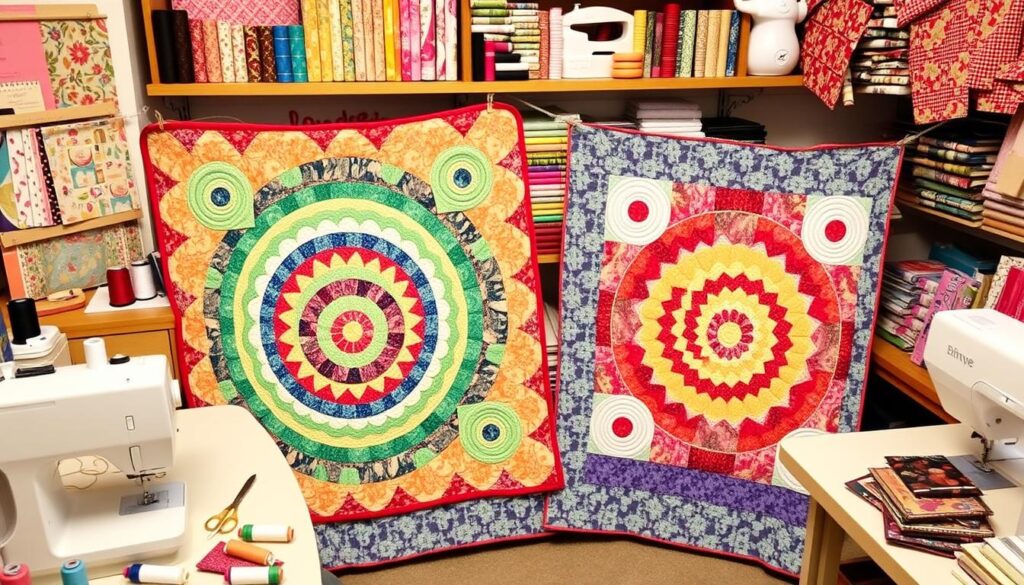
Quilting is not just about sewing two pieces of fabric together; it’s about creating a work of art that tells a story and brings people together.
Try different techniques and designs to make your quilts special. Whether you’re new or experienced, quilting offers endless possibilities. It’s a journey of learning and growth.
Adding Beautiful Borders and Binding
To finish your baby quilts, think about adding quilt borders and binding. These details can make your quilts look even better and give them a polished finish. You can pick from simple strip borders or more complex designs, based on your skill and taste.
Some favorite quilt border choices include:
- Strip borders: These are simple and great for beginners.
- Pieced borders: These use many fabric pieces for a detailed design.
- Appliqué borders: These add fabric shapes or designs for extra interest.
For binding, you have options like traditional, decorative, or machine-binding. Each has its own benefits and drawbacks. It’s key to pick the one that fits your skill and the quilt’s style.
After adding borders and binding, you can add the last touches. This might be a label or a decorative stitch. These steps will make your baby quilts complete and ready to use. By doing this, you’ll create quilts that are not only beautiful but also professional-looking, cherished for many years.
| Quilt Border Option | Description |
|---|---|
| Strip Border | A simple and easy-to-create border option |
| Pieced Border | A unique and intricate border option that involves sewing together multiple pieces of fabric |
| Appliqué Border | A border option that involves applying fabric shapes or designs to the border of the quilt |
Troubleshooting Common Issues
Quilting can sometimes go wrong, even with the best plans. Learning to fix problems is key. Issues like uneven seams can be a big challenge.
First, find out why your seams are uneven. It might be because of wrong seam allowance, uneven fabric, or sewing tension. To fix it, try adjusting your seam allowance. Or, use a special foot on your sewing machine. Pressing your seams can also help them lie flat.
- Checking the sewing machine tension and adjusting it if necessary
- Using a seam ripper to carefully remove uneven stitches
- Pressing the quilt blocks and seams to ensure they lie flat
- Using a quilting ruler to ensure accurate cutting and sewing
With these tips and a bit of patience, you can fix uneven seams. This way, you can make quilts that look amazing. Remember, fixing problems is all part of quilting. With time and practice, you’ll get better at it.
| Common Issue | Solution |
|---|---|
| Uneven Seams | Adjust seam allowance, use walking foot or even feed foot, press seams carefully |
| Puckering Problems | Check sewing machine tension, use seam ripper to remove uneven stitches, press quilt blocks and seams |
Care Instructions for Your Finished Quilts
To keep your baby quilts in top shape, follow some key care steps. Wash them in cold water and dry on a low setting. Hand washing is also a gentle option.
Here are some tips for washing quilts:
- Use a mild detergent made for quilts
- Stay away from bleach and harsh chemicals
- Swish the quilt gently in water to mix the soap
- Rinse well to get rid of all soap
When storing your quilts, keep them in a cool, dry spot. You can fold or roll them, but avoid creases that could harm the fabric.
By following these care tips, your baby quilts will stay beautiful for a long time. Always check the care label for specific washing instructions. Also, skip fabric softener and dryer sheets to prevent residue.
Quilt care is crucial for maintaining your quilts’ beauty. These simple steps can help your quilts last longer and stay lovely for years.
Conclusion
Congratulations on finishing your two jelly roll baby quilts! You’ve learned how to sew efficiently and made beautiful, cozy quilts. These quilts will surely become treasured family keepsakes.
As you look at your work, remember the joy of quilting. It’s in the rhythmic stitching, the vibrant fabrics, and seeing your creations come to life.
Whether you’re giving these quilts as gifts or keeping them for your kids, keep exploring jelly roll quilts and baby quilt patterns. Try new color schemes, mix fabrics, and let your creativity flow. These quilts can be tailored to any nursery or personal taste.
Keep enjoying your quilting journey and find happiness in every step. Share your projects and get inspired by others. With time and effort, you’ll keep improving and making lasting legacies for future generations.
Happy quilting, and may your future projects be as rewarding and fulfilling as these jelly roll baby quilts.


